Art therapy offers a powerful means for emotional expression and healing, helping individuals explore feelings that are often hard to articulate. This article covers the benefits of art therapy, techniques used in sessions, challenges faced by participants, and resources available to support this therapeutic approach. Engaging in creative activities can enhance self-awareness, reduce anxiety, and promote overall mental well-being. By incorporating art therapy principles into daily life, individuals can foster emotional resilience and self-discovery.
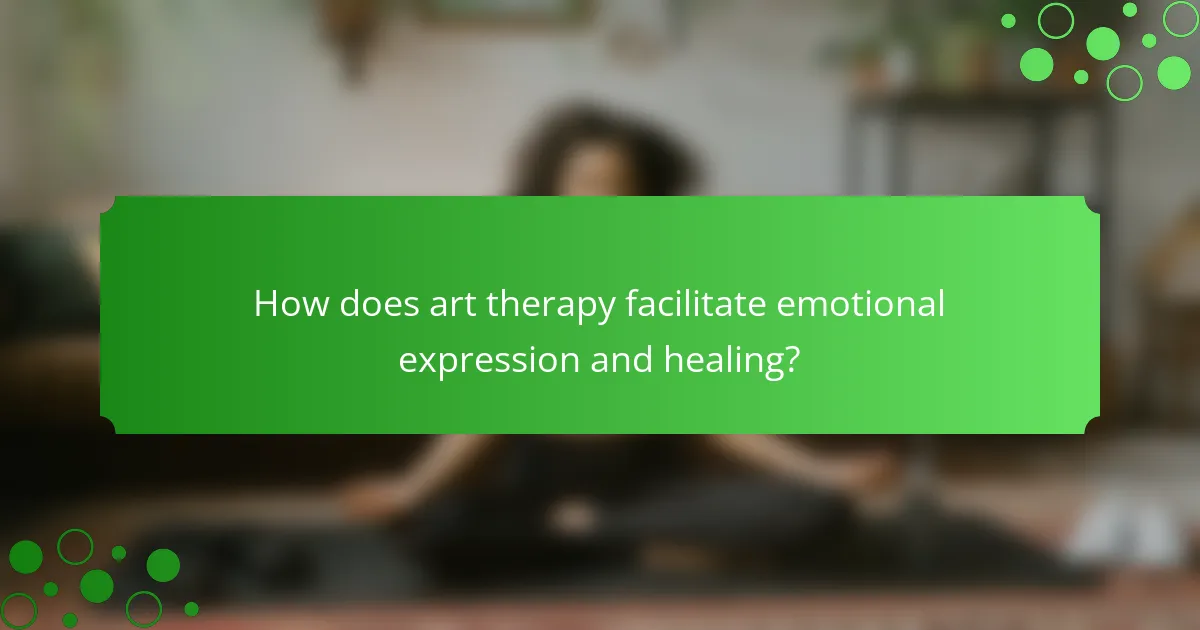
How does art therapy facilitate emotional expression and healing?
Art therapy facilitates emotional expression and healing by providing a creative outlet for individuals to explore their feelings. Through various artistic mediums, participants can communicate emotions that may be difficult to articulate verbally. This process fosters self-discovery and promotes mental well-being.
Research shows that art therapy can reduce symptoms of anxiety and depression. Engaging in creative activities releases endorphins, enhancing mood and emotional resilience. Moreover, art therapy sessions often create a safe space, allowing individuals to confront and process trauma in a supportive environment.
The unique attribute of art therapy lies in its ability to cater to diverse populations, including children and adults with different backgrounds and mental health challenges. Each individual’s experience with art therapy is distinct, influenced by personal history and artistic expression.
As a result, art therapy not only aids in emotional expression but also contributes to holistic healing, making it a valuable tool in therapeutic settings.
What are the psychological principles behind art therapy?
Art therapy utilizes psychological principles to facilitate emotional expression and healing. It promotes self-discovery, enhances coping skills, and fosters communication through creative processes.
Art therapy incorporates theories such as cognitive-behavioral approaches, which help individuals reframe negative thoughts. Additionally, it leverages psychodynamic principles to explore unconscious feelings, enabling deeper emotional insights.
The therapeutic relationship is crucial, as it provides a safe space for expression. This environment encourages vulnerability, allowing clients to confront and process complex emotions.
Research indicates that art therapy reduces symptoms of anxiety and depression. A study found that 75% of participants reported improved emotional well-being after art therapy sessions.
Which emotions can be expressed through art therapy?
Art therapy can express a wide range of emotions, including joy, sadness, anger, fear, and anxiety. Through creative processes, individuals can explore and communicate their feelings. This form of therapy facilitates emotional release and healing by allowing participants to visualize and process complex emotions. Art therapy uniquely enables individuals to articulate feelings that may be difficult to express verbally, promoting self-awareness and emotional understanding.
How does art therapy compare to traditional talk therapy?
Art therapy offers a creative approach to emotional expression, while traditional talk therapy relies on verbal communication. Art therapy can facilitate non-verbal expression, making it beneficial for individuals who struggle to articulate feelings. Research indicates that art therapy may enhance emotional processing and provide unique insights into personal experiences. In contrast, traditional talk therapy emphasizes cognitive restructuring and verbal exploration of thoughts and feelings. Both methods aim for healing but differ in techniques and engagement styles.
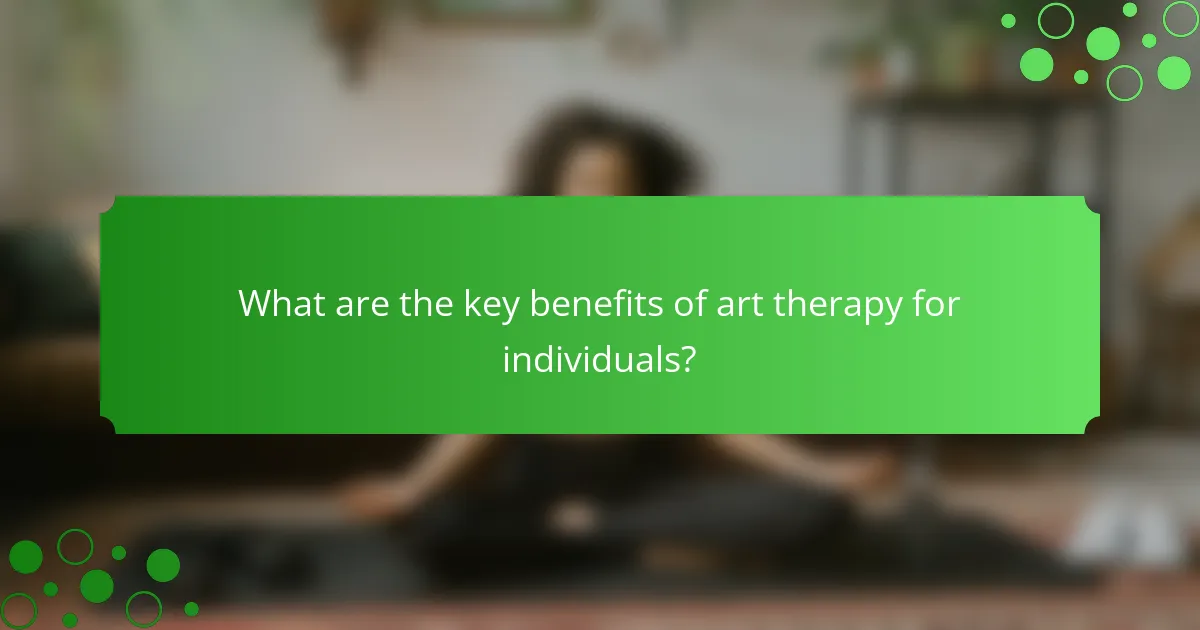
What are the key benefits of art therapy for individuals?
Art therapy provides numerous benefits for emotional expression and healing. It enhances self-awareness, reduces anxiety, and fosters emotional resilience. Participants can communicate feelings non-verbally, which is particularly beneficial for those struggling to articulate emotions. Art therapy also promotes relaxation and a sense of accomplishment, contributing to overall mental well-being. Research indicates that engaging in creative activities can lead to significant improvements in mood and emotional health.
How does art therapy promote self-awareness and personal growth?
Art therapy promotes self-awareness and personal growth by encouraging individuals to express emotions creatively. This therapeutic approach helps clients explore their thoughts and feelings through artistic mediums, leading to greater insight into their inner selves. Engaging in art therapy fosters reflection, enabling individuals to identify and process emotions they may struggle to articulate verbally.
Additionally, the act of creating art can enhance self-esteem and confidence, as individuals witness their capabilities and progress. Research indicates that art therapy can significantly reduce symptoms of anxiety and depression, further supporting emotional healing and personal development. By facilitating a non-judgmental space, art therapy nurtures a deeper understanding of self, promoting holistic growth.
What role does creativity play in emotional healing?
Creativity plays a crucial role in emotional healing by facilitating self-expression and processing emotions. Art therapy harnesses creative activities to help individuals explore feelings, reduce anxiety, and enhance self-awareness. Engaging in artistic expression can lead to significant psychological benefits, such as improved mood and emotional resilience. Research shows that expressing emotions through art can activate brain regions associated with emotional regulation, making it a unique form of therapeutic intervention.
Which populations benefit most from art therapy?
Individuals with mental health challenges, trauma survivors, children with emotional difficulties, and elderly populations benefit most from art therapy. These groups often find expression, healing, and coping mechanisms through creative processes. For example, trauma survivors can process emotions and experiences in a non-verbal manner, which can be less intimidating than traditional talk therapy. Additionally, children may engage more readily in art activities, allowing for emotional expression that might be difficult to articulate. Elderly individuals often use art therapy to combat feelings of isolation and to stimulate cognitive function.
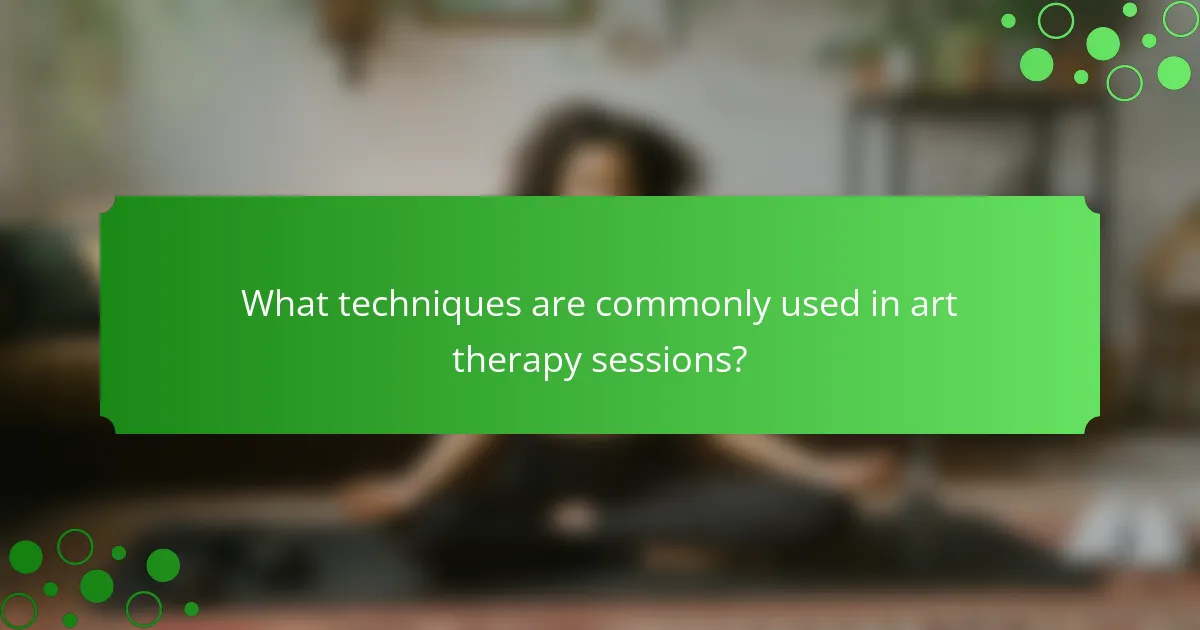
What techniques are commonly used in art therapy sessions?
Art therapy sessions commonly use techniques such as drawing, painting, sculpture, and collage. These methods facilitate emotional expression and promote healing. Each technique allows individuals to explore feelings, reduce anxiety, and improve self-awareness. For example, drawing can help articulate complex emotions that are difficult to verbalize.
How are different art forms utilized in therapy?
Art therapy employs various art forms to facilitate emotional expression and healing. Techniques include painting, drawing, sculpture, music, and dance. Each form allows individuals to explore feelings and experiences creatively. For example, painting can help express emotions that are difficult to verbalize. Music therapy may enhance mood and provide a sense of connection. Dance therapy promotes physical movement and emotional release. These art forms are essential for fostering self-discovery and personal growth in therapeutic settings.
What is the role of guided imagery in art therapy?
Guided imagery plays a significant role in art therapy by enhancing emotional expression and facilitating healing. It allows individuals to visualize their thoughts and feelings, which can be transformed into artistic representations. This process promotes self-reflection and insight, leading to improved emotional regulation. Guided imagery can also reduce anxiety and stress, creating a safe mental space for creativity. As a result, clients often experience deeper connections to their artwork and gain valuable perspectives on their emotional challenges.
How can art therapy be adapted for children versus adults?
Art therapy can be adapted for children by using more playful, hands-on activities, while adults benefit from deeper, reflective processes. Children often express emotions through drawing and crafting, allowing for spontaneous creativity. In contrast, adults may engage in structured art projects that encourage introspection and discussion.
For children, art therapy sessions often incorporate storytelling and imaginative play, helping them articulate feelings non-verbally. Adults typically explore themes of personal history and emotional challenges through more complex mediums like painting or sculpture.
The duration of sessions may differ; children’s sessions are usually shorter, around 30-45 minutes, while adults may engage for 60-90 minutes. The therapeutic goals also vary, with children’s focus on emotional regulation and social skills, while adults often aim for trauma processing and self-discovery.
Overall, adapting art therapy involves recognizing developmental stages and emotional needs, ensuring that both children and adults find healing through creative expression.
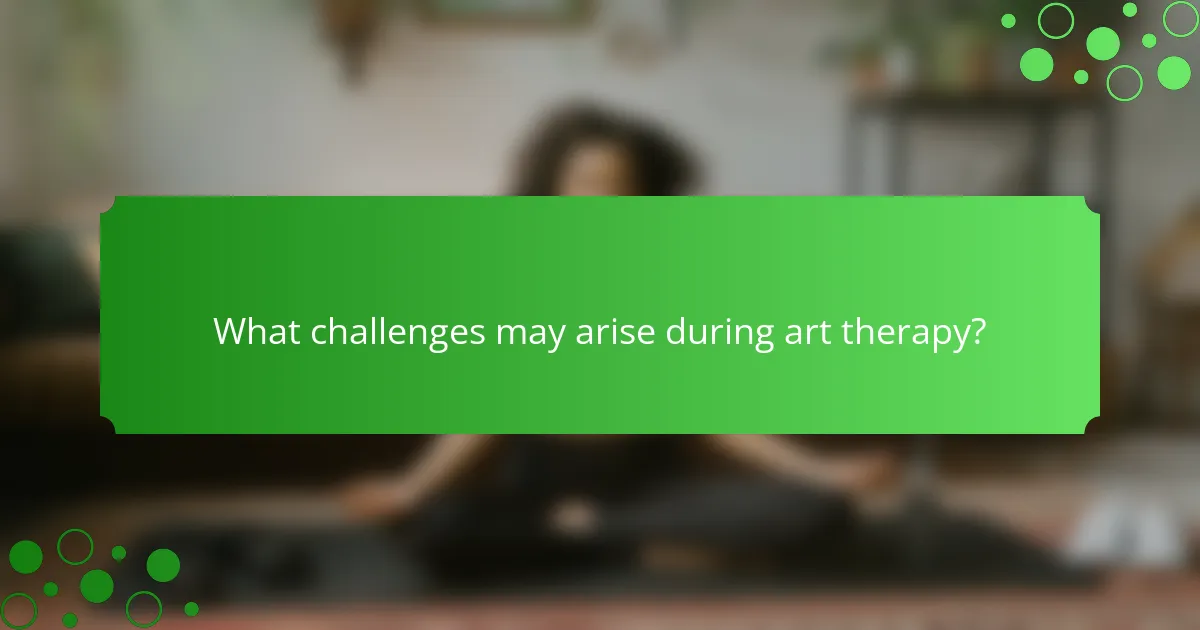
What challenges may arise during art therapy?
Art therapy can present various challenges, including emotional resistance, difficulty in self-expression, and varying levels of artistic skill. Participants may struggle to articulate feelings or confront painful memories. Additionally, some individuals may feel intimidated by the creative process, leading to frustration or withdrawal. Establishing a safe and supportive environment is crucial to overcoming these obstacles and facilitating healing.
How can therapists address resistance to art therapy?
Therapists can address resistance to art therapy by building trust, using gentle encouragement, and allowing clients to express their feelings. Establishing a safe environment fosters openness. Therapists should validate clients’ emotions and highlight the therapeutic process’s benefits. Engaging clients with familiar materials can ease anxiety. Offering choices in art-making promotes autonomy and reduces resistance.
What are common misconceptions about art therapy?
Many people mistakenly believe that art therapy is solely about creating art. In reality, it focuses on emotional expression and healing through the creative process. Another common misconception is that art therapy is only for artists; however, it benefits individuals regardless of their artistic skills. Some think it is a quick fix for mental health issues, but effective therapy often requires time and commitment. Additionally, there is a belief that art therapy is not evidence-based, while numerous studies support its effectiveness in improving mental well-being. Lastly, some assume it is only for children, yet adults also gain significant benefits from engaging in art therapy.
How can cultural differences impact the effectiveness of art therapy?
Cultural differences can significantly influence the effectiveness of art therapy by shaping emotional expression and communication styles. Different cultures have unique values and beliefs that affect how individuals perceive and engage with art. For instance, some cultures may prioritize communal expression, while others emphasize individual creativity.
Art therapy may be more effective in cultures that value emotional openness, as clients are likely to engage more freely in the therapeutic process. Conversely, in cultures where emotional restraint is the norm, clients may struggle to express themselves through art. This can impact the therapeutic outcomes and the overall healing process.
Additionally, the choice of art materials and subjects can vary across cultures, influencing the therapeutic experience. Understanding these cultural nuances is essential for therapists to tailor their approaches effectively, ensuring that art therapy resonates with clients from diverse backgrounds.
In summary, art therapy’s success relies on recognizing and integrating cultural differences, which can enhance emotional expression and healing.
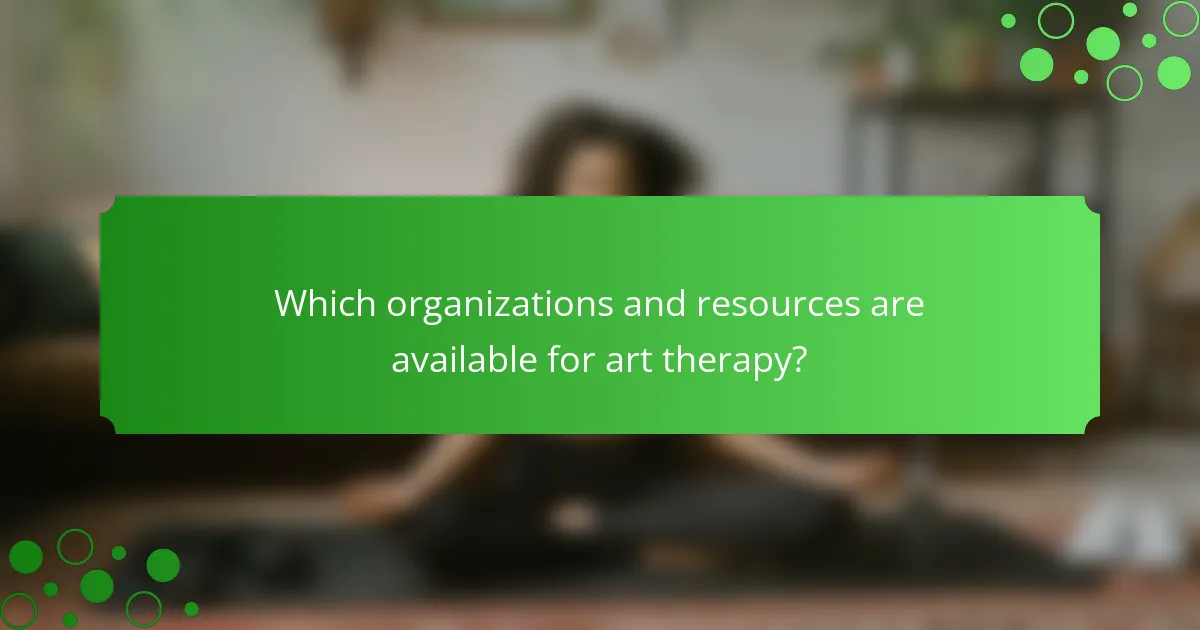
Which organizations and resources are available for art therapy?
Numerous organizations and resources support art therapy for emotional expression and healing. Notable organizations include the American Art Therapy Association, which offers certification and resources for practitioners. The Art Therapy Credentials Board provides credentialing for art therapists, ensuring professional standards. Additionally, local community centers and mental health organizations often offer art therapy programs. Online platforms like the Art Therapy Alliance provide resources and a network for therapists and clients alike. These resources enhance access to art therapy and promote its benefits for mental health.
What certifications should art therapists have?
Art therapists should have relevant certifications such as a master’s degree in art therapy and credentials from recognized organizations. Key certifications include Registered Art Therapist (ATR) and board certification from the Art Therapy Credentials Board (ATCB). These qualifications ensure professionals are equipped to facilitate emotional expression and healing through art.
Which professional associations promote art therapy?
Several professional associations promote art therapy, emphasizing its role in emotional expression and healing. Notable organizations include the American Art Therapy Association, which advocates for the field and provides resources for practitioners. The British Association of Art Therapists offers guidelines and training for professionals in the UK. Additionally, the Canadian Art Therapy Association supports art therapists through networking and development opportunities. These associations play a crucial role in standardizing practices and promoting awareness of art therapy’s benefits.
What online resources provide support for art therapy practitioners?
Numerous online resources support art therapy practitioners. These include professional organizations, educational platforms, and community forums that provide valuable tools and insights.
1. American Art Therapy Association (AATA) – Offers resources, training, and networking opportunities for professionals.
2. Art Therapy Credentials Board (ATCB) – Provides certification and information on ethical practices in art therapy.
3. Online courses – Platforms like Coursera and Udemy offer specialized courses in art therapy techniques.
4. Social media groups – Facebook and LinkedIn host communities for sharing experiences and resources among practitioners.
5. Research databases – Access to journals and studies through platforms like JSTOR or Google Scholar supports evidence-based practice.
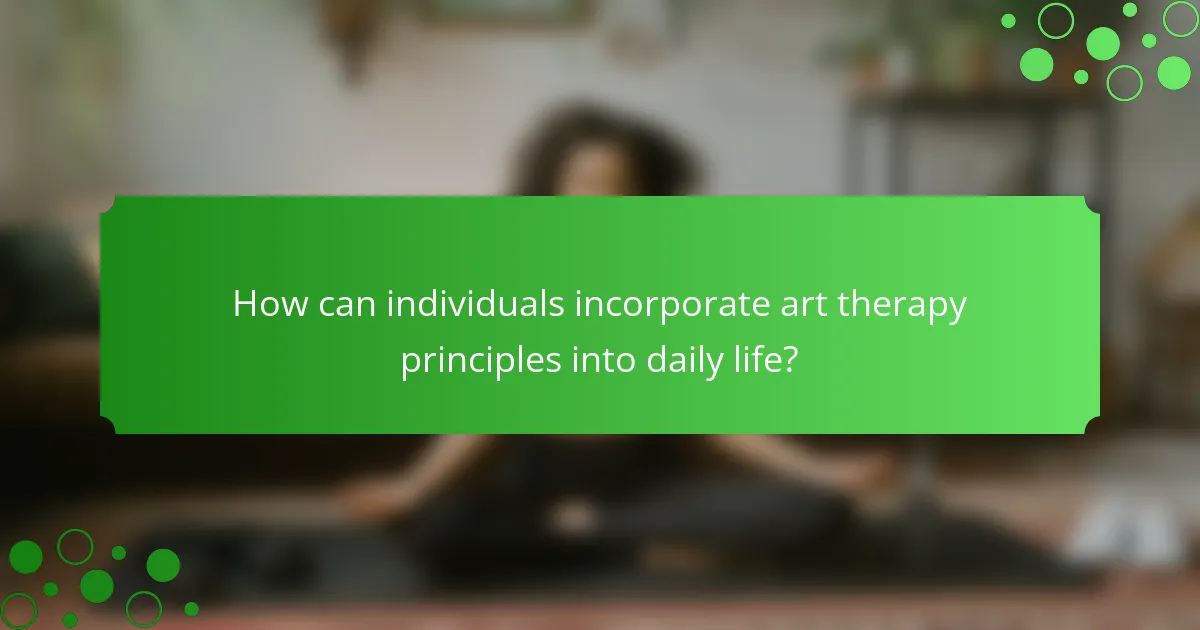
How can individuals incorporate art therapy principles into daily life?
Individuals can incorporate art therapy principles into daily life by engaging in creative activities that promote emotional expression. Simple practices include drawing, painting, or journaling to explore feelings. Creating a designated space for art can enhance the experience. Regularly setting aside time for these activities fosters mindfulness and self-reflection. Joining community art classes or online workshops can provide structure and social support. These practices not only aid in emotional healing but also cultivate a deeper understanding of oneself.
What are some DIY art therapy exercises for self-exploration?
DIY art therapy exercises for self-exploration include various creative activities that promote emotional expression. These exercises can enhance self-awareness and facilitate healing.
1. Create a feelings collage using magazine cutouts to represent emotions visually.
2. Engage in free drawing or painting without a specific goal to explore subconscious thoughts.
3. Use guided imagery to visualize a peaceful place, then illustrate it to express inner peace.
4. Write and illustrate a personal story or narrative to connect with past experiences.
5. Experiment with colors and shapes in abstract art to reflect mood changes.
6. Create a vision board to manifest personal goals and aspirations.
These activities can foster personal insights and emotional release, making art therapy a valuable tool for self-exploration.
How can journaling and art be combined for emotional processing?
Journaling and art can effectively combine for emotional processing by facilitating self-expression and reflection. Art therapy enhances emotional healing through creative outlets, allowing individuals to visualize feelings. Journaling complements this by providing a structured space for thoughts and insights. Together, they foster deeper emotional understanding and resilience. Engaging in both practices can lead to significant mental health benefits, such as reduced anxiety and improved mood.
What are best practices for seeking a qualified art therapist?
To find a qualified art therapist, prioritize their credentials, experience, and approach to therapy. Look for licensed professionals with specific training in art therapy. Verify their experience with your particular emotional needs. Assess their therapeutic style through initial consultations. Seek recommendations from trusted sources or professional organizations.
What common mistakes should individuals avoid in art therapy?
Individuals should avoid several common mistakes in art therapy to enhance emotional expression and healing. Firstly, neglecting to set clear intentions can lead to unproductive sessions. Secondly, dismissing the therapeutic process as merely recreational undermines its potential benefits. Thirdly, comparing one’s artwork to others can stifle personal expression. Lastly, failing to communicate feelings and thoughts during sessions can limit the healing experience. By recognizing these pitfalls, individuals can maximize the effectiveness of their art therapy journey.